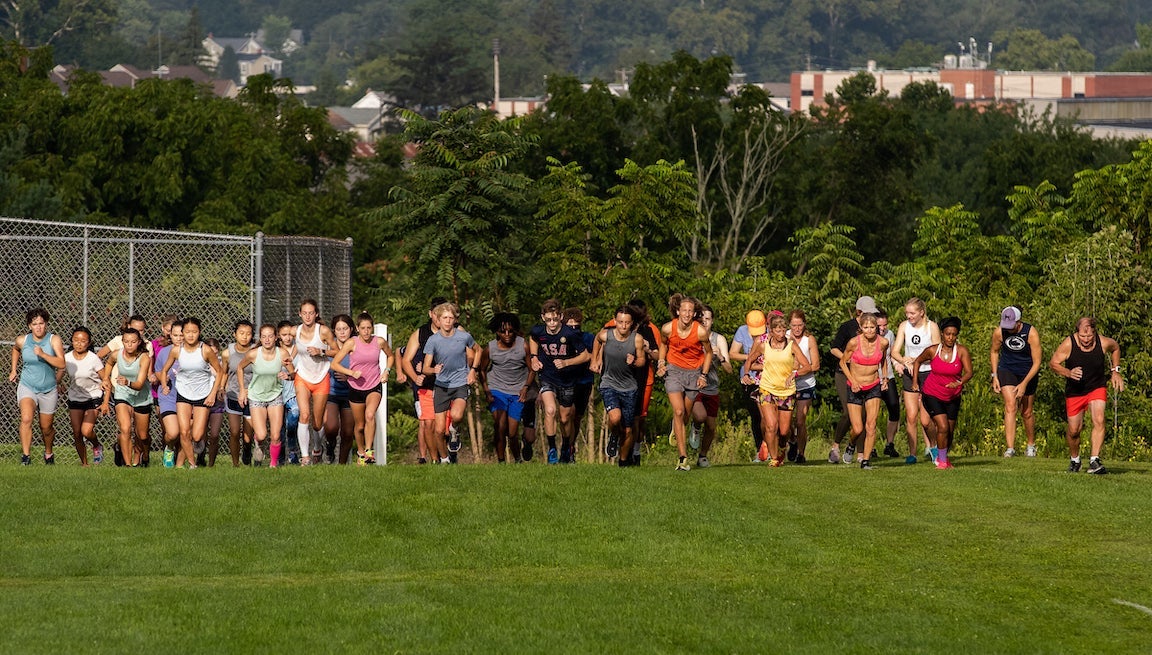Outside of high school and college, few runners experience the hard fun of competing in cross country. That’s unfortunate, because there’s nothing else like it — hills, mud and redline intensity from start to finish. And because channeling XC stars will make you a better runner all around: faster, stronger, more in tune with your body and mentally tough.
To prepare for the specific challenges that XC racing presents, cross country runners do certain types of workouts that the rest of us seldom do. Sprinkling these workouts into your routine will fill gaps in your running fitness and help you achieve your next goal, whatever it may be. Plus, they’re fun! (Yes, and hard.)
Here are four classic cross country workouts to try:
Up-and-Downs

To succeed in cross country, you need to able to not only run strong up hills but also run confidently and efficiently down them. This workout will make you a stronger climber and more confident on steep descents.
1.) Warm up with 1 to 3 miles of easy jogging.
2.) Run at 90 percent effort up a hill with a moderate slope (5-7 percent is ideal, but work with what you have) for 30 seconds.
3.) Rest for 30 seconds.
4.) Run at 90 percent effort down the same hill you just ran up. Since you’ll be going a lot faster, it will take you less time (probably 15-20 seconds) to cover the same distance.
5.) Rest for 30 seconds.
6.) Repeat this sequence a total of four to eight times, depending on your fitness level.
7.) Cool down with 1 to 3 miles of jogging.
Downshift Intervals
Because of the varied terrain involved, as well as tactical considerations, cross country races are seldom evenly paced. Being well prepared for this aspect of the discipline requires that you develop the ability to recover from short bursts of hard running while still running fairly fast. This workout does just that.
1.) Warm up with 1 to 3 miles of easy jogging.
2.) Run for 30 seconds at about the highest speed you could sustain for 1 mile, then slow down to your 10K race pace, give or take, and continue for another 2.5 minutes.
3.) Rest for 1 minute.
4.) Repeat this sequence a total of four to eight times, depending on your fitness level.
5.) Cool down with 1 to 3 miles of jogging.
Stretch Intervals

In cross country, you can’t rely on numbers (split times, pace data, distance markers) to achieve the goal of getting to the finish line as quickly as possible. Instead you need to go by feel, or more specifically perceived effort, continually adjusting your pace to the changing terrain so as to ensure you finish with an empty tank but don’t empty it before you finish. Stretch intervals will make you better at reading your perceived effort level and knowing your limits.
1.) Warm up with 1 to 3 miles of easy jogging.
2.) Run fast uphill for one minute and drop a marker (a brightly colored sock works well) at your stopping point.
3.) Take two minutes to jog easily back to your starting point.
4.) Run uphill fast for one minute again, aiming to cover just slightly more distance this time than you did the first time. Drop a second marker at your stopping point.
5.) Take two minutes to jog easily back to your starting point, picking up your first marker along the way.
6.) Repeat this sequence a total of six to 10 times, depending on your fitness level. Your final repetition should be a maximum effort.
7.) Cool down with 1 to 3 miles of jogging.
The key to executing this workout properly is to avoid running the first hill repetition too fast, so there’s room to speed up by several small increments before you reach your maximum effort level. But you also mustn’t cheat by running the first rep really slow!
Critical Velocity
All runners should do a mix of easy, moderate and hard running. Most runners do their moderate running at or near lactate threshold intensity, which is the highest speed that’s sustainable for roughly one hour. But many cross country runners also mix in some work at critical velocity, which is the highest speed that’s sustainable for 30 minutes and is closer to XC race pace for most. Adding the following workout to your routine will fill one more gap in your fitness.
1.) Warm up with 1 to 3 miles of easy jogging.
2.) Run for 3 minutes at critical velocity on flat or relatively flat terrain.
3.) Jog for 3 minutes.
4.) Repeat this sequence a total of five to 10 times, depending on your fitness level.
5.) Cool down with 1 to 3 miles of jogging.
Note that critical velocity falls between 5K and 10K race pace for most runners. If your 5K time is 29 minutes, for example, your CV pace will be just slightly slower. If your 5K time is 19 minutes, your CV pace will be closer to your 10K pace.


